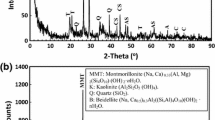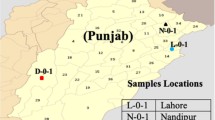Abstract
This study was focused on the correlations between the physical and mechanical properties and geostatistical analysis of the clay of high plasticity (CH) soil based on the experimental data and the data collected from various research studies. Four types of CH soil with liquid limit (LL) of 50, 62, 76 and 88% were collected from the field, tested, compared with the data from literature and qualified using hyperbolic model. X-ray diffraction analyses showed the major constituents of the CH soil with LL of 50% were calcium silicate (Ca2SiO4), aluminum silicate (Al2SiO5) and quartz (SiO2) and the major constituents of the CH soil with LL of 88% were montmorillonite (Na, Ca)0.33(Al, Mg)2(Si4O10)(OH)2·nH2O, kaolinite (Al2Si2O5(OH)4 and quartz (SiO2). The index properties, compacted properties, free swelling and compressive strength of the CH soils were investigated and quantified with over 1000 data collected from the literature. Using the mean (μ), standard deviation (σ), variation (σ2) and coefficient of variation parameters of CH soils properties such as density (γ), index properties (LL and PL), compaction properties (OMC and γ dmax), swelling index (FS), initial void ratio (eo), compression index (Cc) and undrained shear strength (Su) properties were also studied. Liquid limit (LL) of CH soils varied between 50 and 110% and plasticity index (PI) varied between 26 and 72%. The wet unit weight (γ wet) for the CH soils varied from 1.30 to 2.19 gm/cm3. Undrained shear strength (Su) of CH soils were varied from 10 to 184 kPa and quantified very well as a function of liquid limit, plasticity index, moisture content and dry density using the experimental data and data collected from the literature.
















Similar content being viewed by others
References
Al-Mhaidib AI (2008) Mathematical model to predict swelling of expansive soil. In: The 12th international conference of international association for computer methods and advances in geomechanics (IACMAG), pp 1–6
Arulrajah A, Bo MW (2008) Characteristics of Singapore marine clay at Changi. Geotech Geol Eng 26(4):431–441
Ata A, Vipulanandan C (1998) Cohesive and adhesive properties of silicate grout on grouted-sand behavior. J Geotech Geoenviron Eng 124(1):38–44
Berilgen SA, Kılıç H, Ozaydın K (2007) Determination of undrained shear strength for dredged golden horn marine clay with laboratory tests. In: Proceedings of the Sri Lankan geotechnical society’s first international conference on soil and rock engineering. pp 5–11
Bilgin Ö, Mansour E (2013) Variability of soil properties and reliability of empirical equations on soil settlement predictions. In: Foundation engineering in the face of uncertainty: Honoring Fred H. Kulhawy, pp 298–307
Blotz LR, Benson CH, Boutwell GP (1998) Estimating optimum water content and maximum dry unit weight for compacted clays. J Geotech Geoenviron Eng 124(9):907–912
Edil TB, Benson CH, Li L, Mickelson DM, Camargo FF (2009) Comparison of basic laboratory test results with more sophisticated laboratory and in situ tests methods on soils in Southeastern Wisconsin (No. WHRP 09-02)
Federico A (1983) Relationships (cu–w) and (cu–s) for remolded clayey soils at high water content. Riv Ital Geotec 17(1):38–41
Ganji PK (2006) Statistical correlations of geotechnical properties, undrained shear strength, texas cone penetrometer (TCP) blow count values with depth of Houston clayey soil. Thesis, University of Houston
Ganstine DG (1971) Statistical correlations of the engineering properties of the Beaumont clays. Master’s Thesis, Department of Civil and Environmental Engineering, University of Houston
Günaydın O (2009) Estimation of soil compaction parameters by using statistical analyses and artificial neural networks. Environ Geol 57(1):203–215
Gurtug Y, Sridharan A (2004) Compaction behavior and prediction of its characteristics of fine grained soils with particular reference to compaction energy. Soils Found 44(5):27–36
Holtz RD, Kovacs WD (1981). An introduction to geotechnical engineering (no. monograph)
Horpibulsuk S, Shibuya S, Fuenkajorn K, Katkan W (2007) Assessment of engineering properties of Bangkok clay. Can Geotech J 44(2):173–187
Houston WN, Mitchell JK (1971) Property interrelationships in sensitive clays. J Soil Mech Found Div 95:1037–1062
Jeng YS, Strohm WE (1976) Prediction of the shear strength and compaction characteristics of compacted fine-grained cohesive soils. US Waterways Experiment Station
Keller GH, Yincan Y (1985) Geotechnical properties of surface and near-surface deposits in the East China Sea. Cont Shelf Res 4(1):159–174
Kolay PK, Pui MP (2010) Peat stabilization using gypsum and fly ash. UNIMAS E-Journal Civil Eng 1(2)
Lee LT (2004) Predicting geotechnical, parameters for dredged materials using the slump test method and index property correlations. DOER Technical Notes collection (ERDC TNDOER-D-1). US Army Engineer Research and Development Center, Vicksburg, Mississippi. http://www.wes.army.mil/el/dots/doer
Mahar LJ, O’Neill MW (1983) Geotechnical characterization of desiccated clay. J Geotechn Eng 109(1):56–71
Mercado E, McDonald JA (2002) Two new non-destructive methods to measure scour depth and the depth of unknown foundations. In: 2nd international conference on the application of geophysical and NDT methodologies to transportation facilities and infrastructure, Los Angeles, Calif
Mohammed AS (2016) Effect of temperature on the rheological properties with shear stress limit of iron oxide nanoparticle modified bentonite-drilling muds. Egypt J Pet 26(3):791–802
Mohammed AS (2017a) Electrical resistivity and rheological properties of sensing bentonite-drilling muds modified with lightweight polymer. Egypt J Pet
Mohammed A (2017b) Vipulanandan model for the rheological properties with ultimate shear stress of oil well cement modified with nanoclay. Egypt J Pet. https://doi.org/10.1016/j.ejpe.2017.05.007
Mohammed AS, Vipulanandan C (2014) Compressive and tensile behavior of polymer treated sulfate contaminated CL soil. Geotech Geol Eng 32(1):71–83
Mohammed A, Vipulanandan C (2015) Testing and modeling the short-term behavior of lime and fly ash treated sulfate contaminated CL soil. Geotech Geol Eng 33(4):1099–1114
Nagaraj TS, Pandian NS, Narasimha-Raju PSR (1993) Stress state-permeability relationships for fine-grained soils. Geotechnique 43(2):333–336
Nagaraj HB, Reesha B, Sravan MV, Suresh MR (2015) Correlation of compaction characteristics of natural soils with modified plastic limit. Transp Geotech 2:65–77
O’Neill MW, Yoon G (1995) Engineering properties of over consolidated Pleistocene soils of Texas Gulf coast. Transp Res Rec 1479:81–88
Ramiah BK, Viswanath V, Krishnamurthy HV (1970) Interrelationship of compaction and index properties. In: Proceedings of the 2nd southeast asian conference on soil engineering, Singapore, pp 577–587
Roy S, Dass G (2014) Statistical models for the prediction of shear strength parameters at Sirsa, India. Int J Civ Struct Eng 4(4):483
Salih N, Mohammed A (2017) Characterization and modeling of long-term stress-strain behavior of water confined pre-saturated gypsum rock in Kurdistan Region, Iraq. Rock Mech Geotech Eng. https://doi.org/10.1016/j.jrmge.2017.03.009
Sivaruban N (2008) Construction and maintenance issues related to transportation infrastructure. Master’s Thesis, Department of Civil and Environmental Engineering, University of Houston
Sridharan A, Nagaraj HB (2000) Compressibility behavior of remolded, fine-grained soils and correlation with index properties. Can Geotech J 37(3):712–722
Sridharan A, Nagaraj HB (2005) Plastic limit and compaction characteristics of fine-grained soils. Gr Improv 9(1):17–22
Sridharan A, Rao RP (2004) Characterization of Ariake and other marine clays. In: International symposium on lowland technology (ISLT-2004), pp 53–58
Sridharan A, El-Shafei A, Miura N (2002) Mechanisms controlling the undrained strength behavior of remolded Ariake marine clays. Mar Georesour Geotechnol 20(1):21–50
Tiwari B, Ajmera B (2011) A new correlation relating the shear strength of reconstituted soil to the proportions of clay minerals and plasticity characteristics. Appl Clay Sci 53(1):48–57
Usluogullari OF, Vipulanandan C (2011) Stress-strain behavior and California bearing ratio of artificially cemented sand. J Test Eval 39(4):1–9
Vipulanandan C, Krishnan S (1993) XRD analysis and leachability of solidified phenol-cement mixtures. Cem concr res 23(4):792–802
Vipulanandan C, Mohammed AS (2014) Hyperbolic rheological model with shear stress limit for acrylamide polymer modified bentonite-drilling muds. J Pet Sci Eng 122:38–47
Vipulanandan C, Mohammed A (2015a) Effect of nanoclay on the electrical resistivity and rheological properties of smart and sensing bentonite drilling muds. J Pet Sci Eng 130:86–95
Vipulanandan C, Mohammed A (2015b) XRD and TGA, swelling and compacted properties of polymer treated sulfate contaminated CL soil. J Test Eval 44(6):2270–2284
Vipulanandan C, Mohammed A (2015c) Smart cement modified with iron oxide nanoparticles to enhance the piezoresistive behavior and compressive strength for oil well applications. Smart Mater Struct 24(12):125020
Vipulanandan C, Mohammed A (2015d) Smart cement rheological and piezoresistive behavior for oil well applications. J Pet Sci Eng 135:50–58
Vipulanandan C, Mohammed A (2017) Rheological properties of piezoresistive smart cement slurry modified with iron-oxide nanoparticles for oil-well applications. J est Eval 45(6)
Vipulanandan C, Kim MS, Harendra S (2006) Microstructural and geotechnical properties of Houston-Galveston area soft clays. In: Proceeding, Geo Denver, Denver, USA
Vipulanandan C, Ahossin Guezo YJ, Bilgin Ö (2007) Geotechnical properties of marine and deltaic soft clays. In: Advances in measurement and modeling of soil behavior, pp 1–13
Vipulanandan C, Kim MS, Harendra S (2007) Microstructural and geotechnical properties of Houston-Galveston area soft clays. In Advances in measurement and modeling of soil behavior, pp 1–11
Vipulanandan C, Guezo YJ, Bilgin O (2007) Geotechnical properties of marine and deltaic soft clays. In: Proceedings, Geo Denver, Denver, USA
Vipulanandan C, Mohammed A, Samuel RG (2017) smart bentonite drilling muds modified with iron oxide nanoparticles and characterized based on the electrical resistivity and rheological properties with varying magnetic field strengths and temperatures. In: Offshore technology conference
Westerberg B, Müller R, Larsson S (2015) Evaluation of undrained shear strength of Swedish fine-grained sulphate soils. Eng Geol 188:77–87
Yılmaz I (2000) Evaluation of shear strength of clayey soils by using their liquidity index. Bull Eng Geol Environ 59(3):227–229
Acknowledgements
The author would like to thanks, Dr. Cumaraswamy Vipulanandan Director of the Center for Innovative Grouting Materials and Technology (CIGMAT) at the University of Houston, Houston, Texas for his help and support during the study work.
Author information
Authors and Affiliations
Corresponding author
Rights and permissions
About this article
Cite this article
Mohammed, A. Property Correlations and Statistical Variations in the Geotechnical Properties of (CH) Clay Soils. Geotech Geol Eng 42, 843–858 (2024). https://doi.org/10.1007/s10706-017-0418-2
Received:
Accepted:
Published:
Issue Date:
DOI: https://doi.org/10.1007/s10706-017-0418-2




